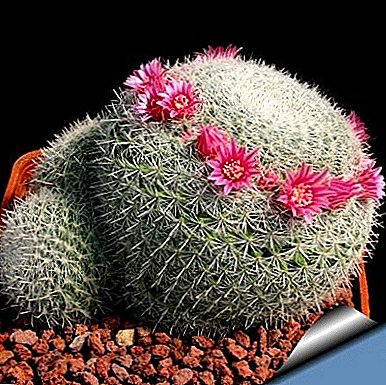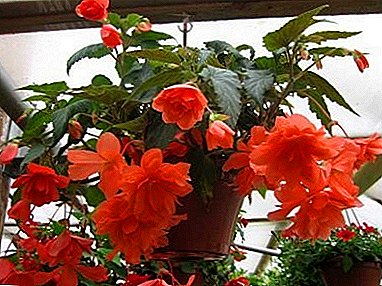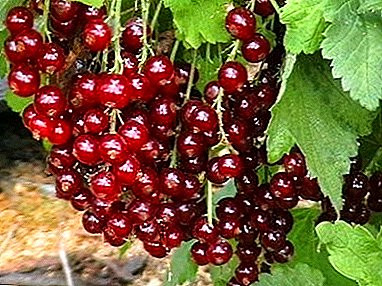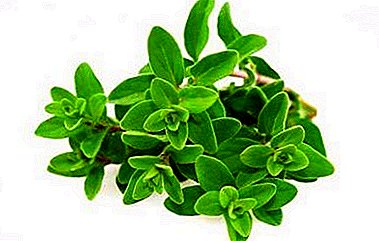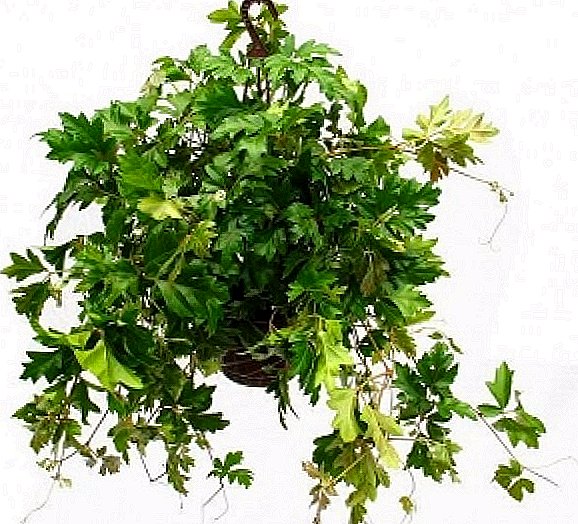
Grapes are very often grown not only as a garden plant for its tasty fruits, but also as a plant for decoration.
After all, thanks to the special shape of the grape bush and its ability to wrap around even 5-meter-high supports, it can easily decorate both a gazebo and a 3-storey house.
At the same time, few people know that you can plant your own home from the inside with the help of grapes.
This can be done through indoor grapes, better known as "birch", "southern grapes" or "grape ivy".
Below we describe the features of this plant and how to properly plant and grow it at home.
Features and differences of indoor grapes from ordinary grapes
The correct scientific name for indoor grapes is cissus. This is a whole species of indoor plants, having a direct relationship with ordinary grapes. Grow it at home is very simple, because the plant is absolutely not whimsical to care. It is worth paying attention to the good endurance of this plant, which is able to endure long periods of time without irrigation, temperature drops to 12ºС.
Cissus has no fruit, pleases only with a huge abundance of greenery and strong growth. With regular feeding, its vine can entwine half of the room, which is also facilitated by strong antennae.
Features of the appearance and growth of indoor grapes

Indoor grapes is a plant with a thin vine covered with lush foliage. With the growth he has a large number of shoots, which are also very thin. Thereby, the plant has very small weight and flexibility. Antennae, which are formed on shoots of cissus, have a spiral shape. They very easily cling to any objects in the house and to special supports.
The leaf form of the most common type of cissus, which is called "birch", is very similar to the leaves of real birch. With an elongated ovoid shape, they have a dense structure and a shiny surface. We have already mentioned that almost all types of cissus very rarely meet flowering. If the plant is flowering, the inflorescences are almost invisible, because they have very small size and appearance. Flowers are collected in false umbrellas that do not form fruits.
Varieties of indoor grapes: we select a plant to taste
It is very important to note that in addition to the "birch" there are many other types of cissus, which can be easily purchased and planted at home. The most popular in our time are the "Cissus Antarctic", as well as "Cissus Rhombic (Rombolist)". They gained their popularity not only due to external beauty, but also to their unpretentiousness and ability to grow even in shaded rooms. What are the features of each of them will tell in order.
Features of "Cissus Rombolic": what is the beauty of indoor plants
This indoor grape got its name directly from the shape of its sheets. In contrast to the usual and most common "birch" with ovoid leaves, this plant leaves have a very complex diamond shape. This is the fastest growing plant of all types of indoor grapes. In just one season, it can grow by more than 2 meters. For the growth of "Cissusu Rombolistnomu" fit any support, for which he can easily cling thanks to a strong mustache.
The most important advantage of this species is its extraordinary stability and unpretentiousness.
Among all other species, it is best mastered both in dark corridors and on overly refreshed window sills. The ability to tolerate even very strong temperature fluctuations makes it possible to decorate open verandas or gazebos with this plant during the summer period.
In any case, he needs support to grow. Its strength does not matter, because, despite the large size, the weight of the bush is very small.
"Cissus Antarctic" - description of an evergreen indoor plant
This plant is found under another very interesting name - "Liana Kangaroo". Its difference from other types of indoor grapes lies in the peculiarities of the development of the bush: its shoots have a rusty appearance. The leaves are heart-shaped and rather large in size - an average of 11x7 centimeters.

The flowering of this bush is absolutely not nice. The flowers have very small sizes, they are green in color, for which reason they do not stand out against the background of leaves.
Virtues This type of houseplant is that it can be left for long periods without irrigation. At the same time, the bush will keep the same fresh look. But in terms of deficiencies "Cissus Antarctic", then they have a sufficiently large number. In particular, the plant can tolerate the winter very painfully, since the humidity of the air is significantly reduced in cold weather.
Also him very high summer temperatures are contraindicated, because of which the leaves of this indoor grapes can dry up. Place a pot or tub with this plant should be chosen very carefully, because it is not well tolerated as strong shading, and too much abundance of sunlight and heat.
Differences and features of "Cissus Striped"
This grape has recently become less common as a houseplant. Perhaps this is due to its great similarity with the girl's grapes, which is a garden ornamental plant. Especially great similarity of these two types of grapes is in the form of a leaf.
The positive qualities of this type of plant is its very rapid growth. In addition, unlike other indoor grapes, "Cissus Striped" does not require high humidity, and grows well in rooms with dry air.

The features of this plant are also as follows:
• The most optimal air temperature for growing "Cissus Striped" is a thermometer indicator of + 16ºС. However, the plant easily tolerates lowering the temperature to + 7ºС. Winter is better tolerated in rooms with cooler air.
• When the summer temperature rises to + 22ºС, a room where the air is well ventilated, but there are no drafts.
• In the summer, the bush of "Cissus Striped" is very important to be watered regularly, but this should be done no more often than the soil will dry out in a plant pot.
• If you want your plant to have a more bushy shape, the tips of the shoots can be trimmed. This will not affect the general condition of this plant species.
Individual characteristics of the "Cissus quadrangle": what are the differences of the plant?
This plant, like all previous ones, is an evergreen vine. Sometimes you can find such a name as "Cissus Cactus", obtained due to the meaty structure of the whole plant. The main feature of it is in the form of shoots: they are not round, but 4-sided, presented as succulents. The color of the shoots is green.
Leaves forming on the shoots are trilobed. The size of the leaves is very small, constantly fall. Another difference between the "Cissus quadrangle" is that this plant has very slow growth.
In traditional medicine "Cissus quadrangle" is used very widely. In particular, it is very famous as a means for losing weight.
Same, such properties are knownsuch as reducing stress, improving metabolism, improving immune stability, can contribute to the quality of healing of fractures and acts as a means to alleviate pain. It also treats varicose veins and hemorrhoids.
Plant and paint your house with the help of the indoor "Cissus the Multicolored"
Unlike all previous types of indoor grapes, Cissus Multicolored is the most fastidious to grow, although in appearance it is the most beautiful. The leaves of this plant are quite large and have a motley color. When you look at these petals, one gets the impression that someone had inflicted a very interesting pattern on them, combining red, silver and purple tones.

The plant will interest anyone with its appearance, but the difficulty lies in bringing this plant to us from the tropics. For this reason, the plant It has many whims and features:
• The usual climate for "Cissus the Multicolored" is a temperature not lower than + 25ºС. Optimum air humidity is about 85%.
• Even in winter, this room grape requires a temperature not lower than + 15 ° C, although it is best to keep it at a temperature of + 23 ° C.
• Since the plant is very capable of growing and has a very long vine with many shoots, it requires a lot of moisture obtained from the soil. Under natural conditions, the inhabitants of Java use its vines as a source of life-giving moisture. At home, "Cissusu Multicolored" requires a very large pot and very frequent and regular watering.
• Unlike other species, the Cissus the Multicolored can throw off its leaves for the winter. In such a state of tranquility, its stems can even be pruned, as well as on large fruit-bearing bushes. In the spring of this bush re-bloom and becomes even more magnificent.
Features of reproduction and planting room grapes
Despite the fact that all the described plant species are directly related to the grape crop, the characteristics of their reproduction have more similarities with the planting of indoor plants, which they, in fact, are. Below we describe in detail how and where it is better to grow this wonderful plant.
Terms of planting indoor grapes: what features you need to know
This plant is propagated by cuttings or dividing the bush. In the first variant, only apical cuttings are used, which are capable of rooting perfectly. For the stem to take root, it is placed in water for a while. After that, planted in a pot. It is best to plant several cuttings, which will get a thicker and lush bush. However, the lush the shrub, the larger the pot should be for the plant.

As for the timing of planting this plant, they can include any time of year. However, taking into account the fact that some types of indoor grapes shed their leaves in winter and fall into a dormant period, spring and summer are the best times for this. It is during these periods that the plant is in the active growth stage, therefore, when rooting its roots, rooting occurs rather quickly.
As for the case, if you decided to propagate the indoor grapes by dividing the bush, then spring time would be better. After all, it is recommended to transplant grapes in spring, in the process of which it is very easy to plant another plant.
Ways to grow indoor grapes
Indoor grapes belong to the ampelous plants, that is, grown in pots in a suspended form. This plant, lowering its vines down and clinging to other supports, is capable of planting a large enough space in the room. But besides this, it is possible to grow "birch" in ordinary slides on the floor. If you build a special support, it will trail up or in any direction convenient for you.
What are the features of care for indoor grapes: instructions and tips
After planting any home plant, and especially indoor, care is required. And this care must necessarily take into account all its features and requirements. So that you do not have any difficulties with growing all the above-mentioned types of indoor grapes, we will describe in detail the most important aspects of caring for this plant, answering the most popular questions.
It is also interesting to read about girlish grapes.
Where to put a pot with indoor grapes?
Unlike ordinary garden grapes, indoor is absolutely does not like an excess of sunlight, although most species love the heat. Thus, it is best to place or hang a pot with this plant near the western or eastern window. Thus, there will not be an overabundance of sunlight, but the plants will not be overshadowed too much.
However, “Cissus Rombolist” deserves special attention in this regard. This plant is extremely fond of sunlight, so the pot with him should be put only on the windows on the south side. In the summer it will perfectly master the garden and on the balcony.

How often do you need to water a similar plant?
The peculiarity of this type of plant is that its leaves have a sufficiently large mass, and at high temperatures evaporate an unusually large amount of moisture. Therefore, in spring and summer the plant should be watered constantly and plentifully. Water should be used soft, preferably separated. With the arrival of a cooler period of time, the amount of watering is reduced. In winter, the plant is watered solely in order to maintain the vital activity of its root system.
Is it necessary to feed the house grapes, and which fertilizers can be used?
It is necessary to feed room grapes, as this will contribute to the growth of the plant and its pomp. Fertilizers should be applied to the soil only during the period of the most active growth, that is, in spring and summer. It is used with the simplest complex of fertilizers, intended for indoor plants. Regular feedings - once for 1-2 weeks.
How often do you need to replant a houseplant?
Young, only growing plants, it is desirable to replant each year. This procedure will promote more active growth and increase in volumes of the bush. Adult indoor grapes are recommended to replant only once every 2-3 years. In this case, the more the plant grows, the more the pot for him to pick up. The best time for transplanting is considered to be early spring.
Do indoor grapes affect pests? How to deal with them?
It is not strange, but the indoor grapes did not avoid such a problem as pests. Most often on the leaves and shoots of the bush can be seen leaf aphids and spider mites. They can bring a lot of harm to the plant, cause drying and twisting of the leaves. To prevent this from happening, as soon as you notice such pests on a bush, immediately start combating them.
The most effective way is chemical processing. However, only special preparations can be used for it, as there is a risk of damage to the leaves of the vine.



